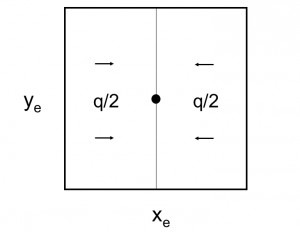Difference between revisions of "6/π stimulated well potential"
From wiki.pengtools.com
(→Math & Physics) |
(→Brief) |
||
| (3 intermediate revisions by the same user not shown) | |||
| Line 2: | Line 2: | ||
[[File:fracture linear flow.png|thumb|right|300px| Stimulated well drainage]] | [[File:fracture linear flow.png|thumb|right|300px| Stimulated well drainage]] | ||
| − | [[6/π stimulated well potential |6/π]] is the maximum possible stimulation potential for pseudo steady state linear flow in a square well spacing. | + | [[6/π stimulated well potential |6/π]] is the maximum possible stimulation well potential for pseudo steady state linear flow in a square well spacing. |
==Math & Physics== | ==Math & Physics== | ||
| Line 53: | Line 53: | ||
==See also== | ==See also== | ||
| + | [[4/π stimulated well potential]]<BR/> | ||
[[JD]]<BR/> | [[JD]]<BR/> | ||
[[:Category:optiFrac | optiFrac]]<BR/> | [[:Category:optiFrac | optiFrac]]<BR/> | ||
| Line 81: | Line 82: | ||
| + | [[Category:pengtools]] | ||
[[Category:Technology]] | [[Category:Technology]] | ||
[[Category:optiFrac]] | [[Category:optiFrac]] | ||
[[Category:optiFracMS]] | [[Category:optiFracMS]] | ||
[[Category:fracDesign]] | [[Category:fracDesign]] | ||
| + | |||
| + | {{#seo: | ||
| + | |title=Hydraulic fracturing formulas 6/π | ||
| + | |titlemode= replace | ||
| + | |keywords=hydraulic fracturing, hydraulic fracturing formulas, well potential | ||
| + | |description=Hydraulic fracturing formulas maximum possible stimulation well potential for pseudo steady state linear flow 6/π | ||
| + | }} | ||
Latest revision as of 06:40, 10 December 2018
Brief
6/π is the maximum possible stimulation well potential for pseudo steady state linear flow in a square well spacing.
Math & Physics
Pseudo steady state flow boundary conditions:
From Diffusivity Equation:
 ( 1 )
( 1 )
From Material Balance:
 ( 2 )
( 2 )
( 2 ) - > ( 1 ) :
 ( 3 )
( 3 )
Integrating ( 3 ):
 must satisfy boundary condition:
must satisfy boundary condition: 
 ( 4 )
( 4 )
Integrating ( 4 ):
 ( 5 )
( 5 )
Since average pressure is:  :
:
See also
4/π stimulated well potential
JD
optiFrac
fracDesign
Production Potential
Nomenclature
 = cross-sectional area, cm2
= cross-sectional area, cm2 = total compressibility, atm-1
= total compressibility, atm-1 = thickness, m
= thickness, m = dimensionless productivity index, dimensionless
= dimensionless productivity index, dimensionless = permeability, d
= permeability, d = pressure, atm
= pressure, atm = initial pressure, atm
= initial pressure, atm = well flowing pressure, atm
= well flowing pressure, atm = average pressure, atm
= average pressure, atm = flow rate, cm3/sec
= flow rate, cm3/sec = one wing volume, m3
= one wing volume, m3 = length, m
= length, m = drinage area length, m
= drinage area length, m = drinage area width, m
= drinage area width, m
Greek symbols
 = porosity, fraction
= porosity, fraction  =viscosity, cp
=viscosity, cp











